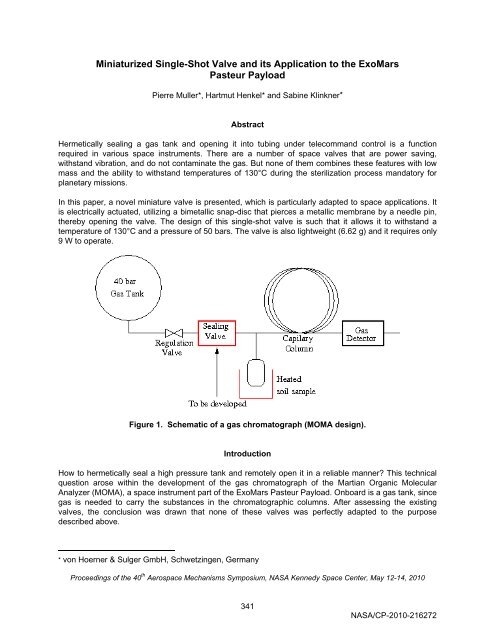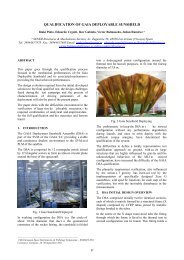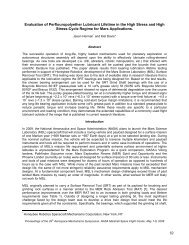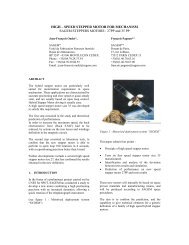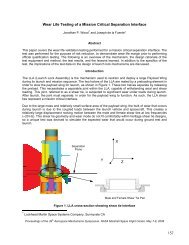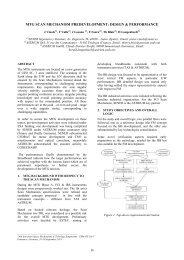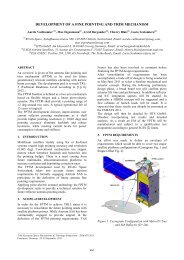Miniaturized Single-Shot Valve and its Application to the ExoMars ...
Miniaturized Single-Shot Valve and its Application to the ExoMars ...
Miniaturized Single-Shot Valve and its Application to the ExoMars ...
Create successful ePaper yourself
Turn your PDF publications into a flip-book with our unique Google optimized e-Paper software.
<strong>Miniaturized</strong> <strong>Single</strong>-<strong>Shot</strong> <strong>Valve</strong> <strong>and</strong> <strong>its</strong> <strong>Application</strong> <strong>to</strong> <strong>the</strong> <strong>ExoMars</strong><br />
Pasteur Payload<br />
Pierre Muller*, Hartmut Henkel* <strong>and</strong> Sabine Klinkner*<br />
Abstract<br />
Hermetically sealing a gas tank <strong>and</strong> opening it in<strong>to</strong> tubing under telecomm<strong>and</strong> control is a function<br />
required in various space instruments. There are a number of space valves that are power saving,<br />
withst<strong>and</strong> vibration, <strong>and</strong> do not contaminate <strong>the</strong> gas. But none of <strong>the</strong>m combines <strong>the</strong>se features with low<br />
mass <strong>and</strong> <strong>the</strong> ability <strong>to</strong> withst<strong>and</strong> temperatures of 130°C during <strong>the</strong> sterilization process m<strong>and</strong>a<strong>to</strong>ry for<br />
planetary missions.<br />
In this paper, a novel miniature valve is presented, which is particularly adapted <strong>to</strong> space applications. It<br />
is electrically actuated, utilizing a bimetallic snap-disc that pierces a metallic membrane by a needle pin,<br />
<strong>the</strong>reby opening <strong>the</strong> valve. The design of this single-shot valve is such that it allows it <strong>to</strong> withst<strong>and</strong> a<br />
temperature of 130°C <strong>and</strong> a pressure of 50 bars. The valve is also lightweight (6.62 g) <strong>and</strong> it requires only<br />
9 W <strong>to</strong> operate.<br />
Figure 1. Schematic of a gas chroma<strong>to</strong>graph (MOMA design).<br />
Introduction<br />
How <strong>to</strong> hermetically seal a high pressure tank <strong>and</strong> remotely open it in a reliable manner? This technical<br />
question arose within <strong>the</strong> development of <strong>the</strong> gas chroma<strong>to</strong>graph of <strong>the</strong> Martian Organic Molecular<br />
Analyzer (MOMA), a space instrument part of <strong>the</strong> <strong>ExoMars</strong> Pasteur Payload. Onboard is a gas tank, since<br />
gas is needed <strong>to</strong> carry <strong>the</strong> substances in <strong>the</strong> chroma<strong>to</strong>graphic columns. After assessing <strong>the</strong> existing<br />
valves, <strong>the</strong> conclusion was drawn that none of <strong>the</strong>se valves was perfectly adapted <strong>to</strong> <strong>the</strong> purpose<br />
described above.<br />
* von Hoerner & Sulger GmbH, Schwetzingen, Germany<br />
Proceedings of <strong>the</strong> 40 th Aerospace Mechanisms Symposium, NASA Kennedy Space Center, May 12-14, 2010<br />
341<br />
NASA/CP-2010-216272
Therefore o<strong>the</strong>r solutions were considered. A self-opening valve consists of two main elements: <strong>the</strong><br />
sealing element, <strong>and</strong> an actua<strong>to</strong>r. All combinations of existing sealing elements <strong>and</strong> actua<strong>to</strong>r were listed,<br />
<strong>and</strong> it appeared that sealing valves is a field that requires more exploration. Who has ever built a sealing<br />
valve with a piezoelectric actua<strong>to</strong>r? To <strong>the</strong> current knowledge this has never been done. This seems also<br />
<strong>the</strong> case for a valve working with a bimetallic snap-disc.<br />
This paper first explains <strong>the</strong> motivation of this development, in particular <strong>the</strong> function <strong>the</strong> valve has <strong>to</strong> fulfill<br />
in <strong>the</strong> MOMA gas chroma<strong>to</strong>graph. After this, <strong>the</strong> basic design <strong>and</strong> <strong>the</strong> refined design of <strong>the</strong> valve are<br />
developed. Finally, <strong>the</strong> valve was tested <strong>and</strong> <strong>the</strong> design reviewed.<br />
Figure 2. Diagram of <strong>the</strong> applications of <strong>the</strong> valve.<br />
Purpose<br />
MOMA is a project of <strong>the</strong> Max Planck Institute for Solar System Research <strong>and</strong> <strong>the</strong> Labora<strong>to</strong>ire<br />
Atmospheres, Milieux, Observations Spatiales. The MOMA objective is <strong>the</strong> analysis of <strong>the</strong> Martian soil<br />
composition during <strong>the</strong> <strong>ExoMars</strong> mission. It consists mainly of a gas chroma<strong>to</strong>graph <strong>and</strong> a laser<br />
spectrometer. The gas chroma<strong>to</strong>graph uses helium <strong>to</strong> carry <strong>the</strong> evolved gases from <strong>the</strong> heated soil<br />
sample <strong>to</strong> <strong>the</strong> capillary columns, as shown in Figure 1. The speed of <strong>the</strong> gas flow is regulated by a<br />
<strong>the</strong>rmal regulation valve in which <strong>the</strong> flow is controlled by a sapphire ball compressed <strong>to</strong> <strong>the</strong> aperture <strong>to</strong> a<br />
higher or lower level. The compression of <strong>the</strong> ball is determined by <strong>the</strong> <strong>the</strong>rmal expansion of <strong>the</strong> body of<br />
<strong>the</strong> regulation valve, which is heated by a resis<strong>to</strong>r. In this continuous process <strong>the</strong> regulation valve opens<br />
as <strong>its</strong> temperature is increased. Here a key problem appears, as <strong>the</strong> entire instrument is heated up during<br />
<strong>the</strong> sterilization process required by <strong>the</strong> committee on space research for missions <strong>to</strong> <strong>the</strong> Martian surface:<br />
If no o<strong>the</strong>r device is hermetically closing <strong>the</strong> gas tank during sterilization, it would lose <strong>its</strong> contents. The<br />
main focus of <strong>the</strong> development presented here is <strong>to</strong> have a valve that truly hermetically seals <strong>the</strong> tank,<br />
before it is opened by breaking <strong>the</strong> seal. The initial hermeticity is <strong>the</strong> key point <strong>to</strong> select a single-shot<br />
valve principle.<br />
The projected valve has <strong>to</strong> be very lightweight (maximum 10 g), as <strong>the</strong> mass budget of <strong>the</strong> scientific<br />
instrument is very limited. The flow rate does not need <strong>to</strong> be very large, as <strong>the</strong> typical flow rate of helium<br />
NASA/CP-2010-216272<br />
342
in gas chroma<strong>to</strong>graphy using capillary columns does not exceed 50 ml/min. However <strong>the</strong> o<strong>the</strong>r<br />
specifications are quite harsh: <strong>the</strong> valve has <strong>to</strong> withst<strong>and</strong> <strong>the</strong> gas tank pressure of 50 bar, <strong>and</strong> a<br />
temperature of 130°C (temperature of <strong>the</strong> sterilization process) should not modify <strong>its</strong> behavior.<br />
A fur<strong>the</strong>r purpose of this work is <strong>to</strong> propose a smaller <strong>and</strong> more rugged alternative <strong>to</strong> <strong>the</strong> existing valves<br />
that provide hermetic sealing at pressures in <strong>the</strong> range of 50 bar. Such valves can have a wide range of<br />
applications. Indeed, it can be used in <strong>the</strong> space industry for deployment of inflatable structures, for<br />
opening of a gas tank for an electrostatic ion thruster or o<strong>the</strong>r space experiments with gas. On <strong>the</strong><br />
ground, it can be used for opening a CO2 tank for active fire protection. A gas tank of an underwater robot<br />
could also be opened <strong>to</strong> bring it at <strong>the</strong> surface.<br />
Existing Sealing <strong>Valve</strong>s<br />
Having an overview of existing valves was a very helpful step of this work. The focus was placed on<br />
single-shot valves, for <strong>the</strong> reason that it seemed <strong>the</strong> only reliable way <strong>to</strong> keep a tank hermetically sealed<br />
years after filling. The first encountered single-shot valve was <strong>the</strong> solenoid valve from <strong>the</strong> company<br />
Industria, France. This valve was already on board <strong>the</strong> Aerosol Collec<strong>to</strong>r Pyrolyzer (a GC-MS) for<br />
Huygens, <strong>and</strong> isolates <strong>the</strong> gas tank of <strong>the</strong> COSAC instrument, part of <strong>the</strong> ESA cometary mission Rosetta.<br />
It consists of a quite bulky solenoid actua<strong>to</strong>r <strong>and</strong> of a thin membrane that obstructs <strong>the</strong> gas flow <strong>and</strong> can<br />
withst<strong>and</strong> pressures up <strong>to</strong> 50 bar. When it is electrically powered, <strong>the</strong> solenoid displaces a pin that<br />
pierces <strong>the</strong> membrane.<br />
Very original o<strong>the</strong>r means <strong>to</strong> pierce a metallic foil <strong>to</strong> open a tank were found for space. In <strong>the</strong> Thermal<br />
Evolved Gas Analyzer on-board with <strong>the</strong> Phoenix Mars mission, <strong>the</strong> gas tanks are opened with a foil<br />
punctured by a wax actua<strong>to</strong>r [1]. Here <strong>the</strong> device is not suited for <strong>the</strong> application because typical fusion<br />
temperatures of wax are below 130°C. Often used in <strong>the</strong> space industry is <strong>the</strong> Pyrovalve, manufactured<br />
by Conax, Florida [2]. It has been used for instance in <strong>the</strong> Titan <strong>and</strong> Delta II NASA missions. Here, <strong>the</strong><br />
gas flow is blocked by a ram that is moved downwards by an explosive initia<strong>to</strong>r placed on a tube above.<br />
The data sheet claims that <strong>the</strong> valve does not contaminate <strong>the</strong> gas <strong>and</strong> that <strong>the</strong> operating pressure<br />
reaches 647 bar. The reasons why it is not suitable for <strong>the</strong> application is <strong>the</strong> maximum s<strong>to</strong>rage<br />
temperature of only 60°C <strong>and</strong> <strong>its</strong> bulky construction.<br />
The Space Science <strong>and</strong> Technology Department, Ru<strong>the</strong>rford Apple<strong>to</strong>n Labora<strong>to</strong>ry has designed a onetime<br />
opening valve for <strong>the</strong> carrier gas tank of <strong>the</strong> P<strong>to</strong>lemy instrument, a gas chroma<strong>to</strong>graph coupled with<br />
a ion trap mass spectrometer built for <strong>the</strong> Rosetta mission [3]. Using this valve, <strong>the</strong> tank is normally<br />
sealed by a hollow <strong>and</strong> frangible pillar. A shape memory alloy (SMA, here Nitinol) actua<strong>to</strong>r, having <strong>the</strong><br />
ability <strong>to</strong> bend when heated over a certain temperature, is placed near this pillar. To release <strong>the</strong> gas, a<br />
heater outside of <strong>the</strong> housing elevates <strong>the</strong> temperature of <strong>the</strong> nitinol actua<strong>to</strong>r, which bends <strong>and</strong> breaks<br />
<strong>the</strong> seal. The pressure of <strong>the</strong> P<strong>to</strong>lemy tank is similar <strong>to</strong> <strong>the</strong> one of MOMA, <strong>and</strong> <strong>the</strong> valve is effective more<br />
than 15 years after filling. But also here <strong>the</strong> low actuation temperature of 76°C prohib<strong>its</strong> <strong>its</strong> use for MOMA.<br />
Interesting is also <strong>the</strong> concept of an alternative <strong>to</strong> <strong>the</strong> Pyrovalve [4] which utilizes three burst discs<br />
(diaphragms specially designed <strong>to</strong> burst at a precise pressure difference) <strong>to</strong> form two chambers. The left<br />
chamber is pressurized at <strong>the</strong> tank initial pressure, while <strong>the</strong> right chamber is pressurized at <strong>the</strong> external<br />
pressure. A heater is able <strong>to</strong> elevate <strong>the</strong> temperature <strong>and</strong> thus <strong>the</strong> pressure inside <strong>the</strong> left chamber. This<br />
causes <strong>the</strong> discs <strong>to</strong> burst in <strong>the</strong> succession middle-left-right. This system has apparently not yet been<br />
realized.<br />
A fur<strong>the</strong>r project, launched by NASA aims at finding an alternative <strong>to</strong> <strong>the</strong> Pyrovalve. The principle is close<br />
<strong>to</strong> <strong>the</strong> one of <strong>the</strong> P<strong>to</strong>lemy valve: <strong>the</strong> actua<strong>to</strong>r is a SMA tube that can be heated from <strong>the</strong> outside. As <strong>the</strong><br />
SMA is heated, it recovers <strong>its</strong> exp<strong>and</strong>ed shape, <strong>and</strong> <strong>the</strong> evolving force breaks a titanium tube responsible<br />
for <strong>the</strong> gas-tightness. Here <strong>the</strong> actuation temperature is linked <strong>to</strong> <strong>the</strong> used alloy nitinol, <strong>and</strong> is <strong>the</strong>refore<br />
approximately <strong>the</strong> same as for <strong>the</strong> P<strong>to</strong>lemy valve. For this reason it cannot be used in MOMA.<br />
343<br />
NASA/CP-2010-216272
On some one-time opening valves, <strong>the</strong> sealing element is nei<strong>the</strong>r broken nor pierced, but melted. The<br />
Angström Space Technology Centre has developed a valve made from two silicon discs or wafers<br />
forming a filter <strong>and</strong> a heater [5]. The gas path is obstructed by an indium solder (melting point 156.6°C),<br />
that can withst<strong>and</strong> 100 bar pressure <strong>and</strong> is melted within 10 s requiring power of 13 W. The silicon<br />
element weighs only 0.4 g, but <strong>the</strong> housing weight amounts <strong>to</strong> 140 g. The Jet Propulsion Labora<strong>to</strong>ry has<br />
also built <strong>the</strong> micro-machined isolation valve, opening when a doped silicon membrane melts (less than<br />
30 mJ are needed). The Pyrex housing has a burst pressure of about 200 bar. A disadvantage of <strong>the</strong>se<br />
valves is that parts from <strong>the</strong> solder can be released in<strong>to</strong> <strong>the</strong> carrier gas, although both valve types<br />
integrate a filter that captures <strong>the</strong> larger particles. Ano<strong>the</strong>r <strong>the</strong>rmally actuated valve using paraffin as seal<br />
was developed, but it can be excluded for <strong>the</strong> MOMA instrument because of <strong>the</strong> low actuation<br />
temperature.<br />
Basic Design<br />
Looking at all <strong>the</strong>se valves increased <strong>the</strong> motivation <strong>to</strong> build a new valve. Also, <strong>the</strong> basics of a sealing<br />
valve were retained: it is always a combination of a sealing element <strong>and</strong> of an actua<strong>to</strong>r. The sealing<br />
element can be a frangible pillar, a shaft, a meltable element or a metallic membrane. All possibilities of<br />
sealing element are used in single-shot valves. However not all possible actua<strong>to</strong>rs have been tried for<br />
such an application. Particularly interesting are actua<strong>to</strong>rs that are activated by a temperature change.<br />
Good examples are <strong>the</strong> regulation valve of MOMA, <strong>the</strong> valve with a wax actua<strong>to</strong>r, or <strong>the</strong> valve with a<br />
shape memory alloy. Indeed it only requires a heater, which is a very simple <strong>and</strong> rugged way <strong>to</strong> transmit<br />
energy. Moreover, <strong>the</strong> heater can be placed outside <strong>the</strong> body of <strong>the</strong> valve, which avoids complications<br />
with cables fed trough <strong>the</strong> body of <strong>the</strong> valve. The only problem with <strong>the</strong>rmal actuation is that <strong>the</strong> activation<br />
temperature has <strong>to</strong> be above 130°C, temperature of <strong>the</strong> sterilization process, with a sufficient margin.<br />
Ideally, <strong>the</strong>re should exist an activation temperature point, <strong>and</strong> <strong>the</strong> actuation should not take place<br />
progressively. Which <strong>the</strong>rmal actua<strong>to</strong>r has a well defined actuation temperature? Shape memory alloys<br />
are very interesting, <strong>and</strong> materials that recover <strong>the</strong>ir shape at temperature over 150°C were searched.<br />
The Company Dynalloy could provide high temperature SMA made of NiTiPt with a recovery temperature<br />
of 300°C. But high temperature SMA is still a field of research, <strong>and</strong> <strong>the</strong>se are very costly elements, only<br />
available in <strong>the</strong> form of wires. A rugged design needs an actua<strong>to</strong>r with a longer heritage. A longer<br />
heritage <strong>and</strong> also high working temperature is given by snap-discs. These are made of two layers of<br />
metals foils with different <strong>the</strong>rmal expansion coefficients <strong>and</strong> bend at a determined temperature. This<br />
actua<strong>to</strong>r was favored because it is very easy <strong>to</strong> fit inside a housing, very light, <strong>and</strong> does not produce any<br />
out-gassing, like <strong>the</strong>rmal actua<strong>to</strong>rs based on phase change.<br />
Having chosen <strong>the</strong> actua<strong>to</strong>r, <strong>the</strong> sealing element remained <strong>to</strong> be selected. Also here, <strong>the</strong> criterion was <strong>the</strong><br />
reliability. Therefore it was looked for a component that has a broad use <strong>and</strong> that benef<strong>its</strong> from wide<br />
knowledge. An attractive device on which <strong>the</strong> design could be based on is called burst disc. It is basically<br />
a thin disc of gas-tight material that ruptures at a certain pressure difference between <strong>the</strong> two sections it<br />
separates. These discs are widely used <strong>to</strong> protect against over-pressures. Similar <strong>to</strong> <strong>the</strong> solenoid valve<br />
from Industria, a membrane could be punctured by a pin attached <strong>to</strong> <strong>the</strong> actua<strong>to</strong>r. The first test showed<br />
that <strong>the</strong> force <strong>and</strong> <strong>the</strong> displacement yielded by <strong>the</strong> bimetallic snap-disc were sufficient <strong>to</strong> clearly pierce a<br />
membrane similar <strong>to</strong> a burst disc calibrated at 150 bar. The next step was <strong>to</strong> design <strong>the</strong> body of <strong>the</strong> valve<br />
with heater, tubes, <strong>and</strong> adequate pin attached <strong>to</strong> <strong>the</strong> snap-disc.<br />
Refined Design<br />
In order <strong>to</strong> ensure a high reliability, some important design parameters have <strong>to</strong> be selected carefully. For<br />
example <strong>the</strong> pin has <strong>to</strong> be fixed in a manner that it cannot accidentally <strong>to</strong>uch <strong>the</strong> membrane, <strong>the</strong><br />
membrane <strong>and</strong> <strong>the</strong> housing have <strong>to</strong> be so thick that <strong>the</strong>y withst<strong>and</strong> <strong>the</strong> high pressure.<br />
First of all, a housing made of stainless steel was chosen, <strong>to</strong> be weld-compatible with <strong>the</strong> 1/16'' (1.6 mm)<br />
outer diameter tubes used in gas chroma<strong>to</strong>graphy. As basic shape, a cylinder was chosen, <strong>to</strong> just fit <strong>the</strong><br />
dimension of a commercial snap-disc that is 12.7 mm. From <strong>the</strong> beginning, a configuration was found,<br />
NASA/CP-2010-216272<br />
344
where <strong>the</strong> snap-disc does not block <strong>the</strong> flow of gas: <strong>the</strong> inlet tube <strong>and</strong> <strong>the</strong> outlet tubes will be placed at<br />
<strong>the</strong> same side of <strong>the</strong> housing, <strong>the</strong> inlet (high pressures) at <strong>the</strong> side <strong>and</strong> <strong>the</strong> outlet with <strong>the</strong> membrane at<br />
<strong>the</strong> center (See Figure 3). This has also <strong>the</strong> advantage <strong>to</strong> let one side free for <strong>the</strong> placement of <strong>the</strong><br />
heater. A heater with a diameter 12.7 mm from <strong>the</strong> manufacturer Minco could be found. It is an ohmic<br />
heater that is very thin <strong>and</strong> lightweight that can heat up <strong>to</strong> a temperature of 200°C. The cover material of<br />
<strong>the</strong> heater is made of Kap<strong>to</strong>n .Because of <strong>its</strong> low out-gassing rate <strong>and</strong> because it remains stable in <strong>the</strong><br />
temperature range of -273°C <strong>to</strong> +400 °C, Kap<strong>to</strong>n is a material that is often used in <strong>the</strong> space industry. The<br />
heater has a hole in <strong>the</strong> middle so that it can be reliably fixed via a screw <strong>and</strong> a cus<strong>to</strong>m-made washer.<br />
As shown in Figure 3, <strong>the</strong> pin is also attached via a hole in <strong>the</strong> middle of <strong>the</strong> snap-disc <strong>and</strong> a washer. The<br />
parts are soldered <strong>to</strong>ge<strong>the</strong>r with a 300°C melting temperature solder. The pin is gold plated <strong>and</strong> <strong>the</strong><br />
washer is made of brass, so it can be soldered without any problem.<br />
The snap-disc <strong>its</strong>elf is held in place by <strong>the</strong> two main parts of <strong>the</strong> housing that form <strong>the</strong> volume for <strong>the</strong><br />
snap-disc where it cannot <strong>to</strong>uch <strong>the</strong> membrane when it is not actuating. It was also verified by CAD that<br />
<strong>the</strong> pin enters in <strong>the</strong> membrane with a reasonable margin. The snap-disc is not fully fixed <strong>to</strong> <strong>the</strong> body of<br />
<strong>the</strong> valve, but has a little play <strong>to</strong> let it bend correctly, this also providing <strong>the</strong>rmal expansion. The snap-disc<br />
does not separate <strong>the</strong> inside of <strong>the</strong> valve in<strong>to</strong> two chambers; a little drilling is in <strong>the</strong> housing equalizes <strong>the</strong><br />
pressures. Hence it is ensured that gas pressure cannot activate <strong>the</strong> snap-disc.<br />
Figure 3. 3D view of <strong>the</strong> inside of <strong>the</strong> valve.<br />
The thickness of <strong>the</strong> housing was determined with a finite element analysis program. The behavior of <strong>the</strong><br />
housing under a pressure of 50 bars was simulated. Resulting from <strong>the</strong> analysis, <strong>the</strong> housing was<br />
reinforced at <strong>the</strong> fixing points of <strong>the</strong> tubes. This resulted in a mechanical fac<strong>to</strong>r of safety using <strong>the</strong> von<br />
Mises yield criterion of 3.34.<br />
All welds were carried out using Nd:YAG Laser technique. The process for welding <strong>the</strong> membrane <strong>to</strong> <strong>the</strong><br />
housing needed some iteration <strong>to</strong> come <strong>to</strong> a gas-tight result, but now <strong>the</strong> process is well determined.<br />
Once <strong>the</strong> valve had been manufactured, <strong>the</strong> overall gas tightness could be verified, <strong>and</strong> also that <strong>the</strong><br />
valve opens when electrically powered.<br />
Design Verification<br />
Testing a single-shot device is a critical issue, because repeatability has <strong>to</strong> be tested over many valves,<br />
<strong>and</strong> <strong>the</strong>refore has <strong>to</strong> be carried out carefully.<br />
A helium leak detec<strong>to</strong>r was used <strong>to</strong> test separately <strong>the</strong> gas-tightness of <strong>the</strong> welds for mounting <strong>the</strong><br />
membrane within <strong>the</strong> housing. No leak could be detected after one hour at 30 bar inner pressure. The<br />
valves were tested in an oven at 130°C <strong>and</strong> it was observed that <strong>the</strong> valves were afterwards still gas-tight.<br />
The opening test was also successful: in average after 90 s of powering <strong>the</strong> valve at 9 W, <strong>the</strong> valve at 30<br />
345<br />
NASA/CP-2010-216272
ar on <strong>the</strong> inlet opens <strong>and</strong> bubbles become visible if <strong>the</strong> outlet is put in water. A test with an open valve<br />
was also carried out, in order <strong>to</strong> observe <strong>the</strong> hole created by <strong>the</strong> pin after actuation.<br />
Never<strong>the</strong>less, <strong>the</strong> valve is still not formally space qualified; this would imply a program with testing of a<br />
large amount of valves, including <strong>the</strong>rmal cycling <strong>and</strong> vibration test.<br />
Conclusion<br />
Bimetallic <strong>the</strong>rmal actuation is a very simple, rugged <strong>and</strong> widely used principle. However, <strong>its</strong> use is mainly<br />
confined in <strong>the</strong>rmal switches where <strong>the</strong> force needed is not large. In some application where a small,<br />
simple actua<strong>to</strong>r, preferably without harness, is required, a st<strong>and</strong>ard snap-disc can be a good choice.<br />
Even though single-shot devices have drawbacks concerning <strong>the</strong>ir testing, <strong>the</strong>y provide a considerable<br />
advantage concerning <strong>the</strong>ir reliability. In <strong>the</strong> specific case of MOMA where a perfectly hermetical device is<br />
required, it is safer <strong>to</strong> choose a sealing element based on single-shot operation.<br />
The valve built (see Figure 4) has <strong>the</strong> advantage over <strong>the</strong> previously foreseen solenoid valve <strong>to</strong> be lighter<br />
by a fac<strong>to</strong>r of ten. Space qualification was taken in<strong>to</strong> account from <strong>the</strong> beginning of <strong>the</strong> design task, <strong>and</strong><br />
testing showed high reliability of <strong>the</strong> device.<br />
Figure 4. Pho<strong>to</strong> of <strong>the</strong> manufactured valves.<br />
References<br />
1. http://planetary.chem.tufts.edu/Phoenix/<strong>the</strong>rmal_evolved_gas_analyzer.htm<br />
2. http://www.conaxfl.com/Aerospace/1832205.htm<br />
3. Edeson, Ruben, Martin Whalley, Barry Kent, Simon Canfer <strong>and</strong> Eric Sawyer. “SMA gas release<br />
mechanism for <strong>the</strong> Rosetta L<strong>and</strong>er's P<strong>to</strong>lemy instrument”, Acta Astronautica, Volume 58, Issue 11, June<br />
2006, pages 576-582.<br />
4. http://www.techbriefs.com/index.php?option=com_staticxt&staticfile=/Briefs/Mar00/MSC22726.html<br />
5. Bejhed, Johan, Pelle Rangsten <strong>and</strong> Johan Kaohler. “Demonstration of a single use microsystem valve<br />
for high gas pressure applications”, Journal of Micromechanics <strong>and</strong> Microengineering, February 2007<br />
NASA/CP-2010-216272<br />
346


